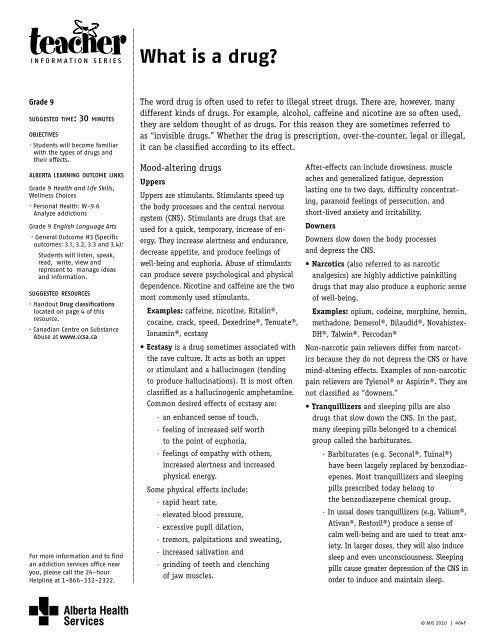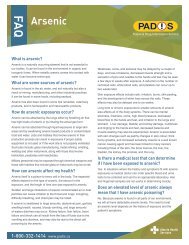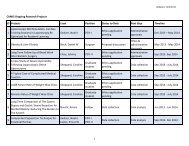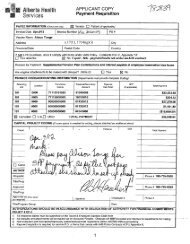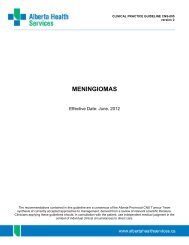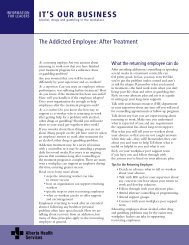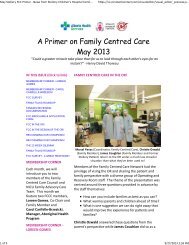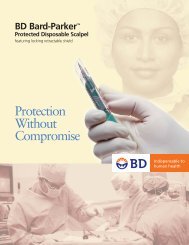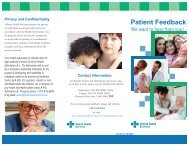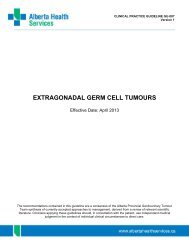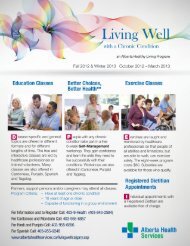Teacher Information Series - What Is a Drug? - Alberta Health Services
Teacher Information Series - What Is a Drug? - Alberta Health Services
Teacher Information Series - What Is a Drug? - Alberta Health Services
Create successful ePaper yourself
Turn your PDF publications into a flip-book with our unique Google optimized e-Paper software.
Grade 9<br />
suggested time: 30 minutes<br />
objectives<br />
· Students will become familiar<br />
with the types of drugs and<br />
their effects.<br />
alberta learning outcome links<br />
Grade 9 <strong>Health</strong> and Life Skills,<br />
Wellness Choices<br />
· Personal <strong>Health</strong>: W-9.6<br />
Analyze addictions<br />
Grade 9 English Language Arts<br />
· General Outcome #3 (Specific<br />
outcomes: 3.1, 3.2, 3.3 and 3.4):<br />
Students will listen, speak,<br />
read, write, view and<br />
represent to manage ideas<br />
and information.<br />
suggested resources<br />
· Handout <strong>Drug</strong> classifications<br />
located on page 4 of this<br />
resource.<br />
· Canadian Centre on Substance<br />
Abuse at www.ccsa.ca<br />
For more information and to find<br />
an addiction services office near<br />
you, please call the 24-hour<br />
Helpline at 1-866-332-2322.<br />
<strong>What</strong> is a drug?<br />
The word drug is often used to refer to illegal street drugs. There are, however, many<br />
different kinds of drugs. For example, alcohol, caffeine and nicotine are so often used,<br />
they are seldom thought of as drugs. For this reason they are sometimes referred to<br />
as “invisible drugs.” Whether the drug is prescription, over-the-counter, legal or illegal,<br />
it can be classified according to its effect.<br />
Mood-altering drugs<br />
Uppers<br />
Uppers are stimulants. Stimulants speed up<br />
the body processes and the central nervous<br />
system (CNS). Stimulants are drugs that are<br />
used for a quick, temporary, increase of energy.<br />
They increase alertness and endurance,<br />
decrease appetite, and produce feelings of<br />
well-being and euphoria. Abuse of stimulants<br />
can produce severe psychological and physical<br />
dependence. Nicotine and caffeine are the two<br />
most commonly used stimulants.<br />
Examples: caffeine, nicotine, Ritalin®,<br />
cocaine, crack, speed, Dexedrine®, Tenuate®,<br />
Ionamin®, ecstasy<br />
• Ecstasy is a drug sometimes associated with<br />
the rave culture. It acts as both an upper<br />
or stimulant and a hallucinogen (tending<br />
to produce hallucinations). It is most often<br />
classified as a hallucinogenic amphetamine.<br />
Common desired effects of ecstasy are:<br />
· an enhanced sense of touch,<br />
· feeling of increased self worth<br />
to the point of euphoria,<br />
· feelings of empathy with others,<br />
increased alertness and increased<br />
physical energy.<br />
Some physical effects include:<br />
· rapid heart rate,<br />
· elevated blood pressure,<br />
· excessive pupil dilation,<br />
· tremors, palpitations and sweating,<br />
· increased salivation and<br />
· grinding of teeth and clenching<br />
of jaw muscles.<br />
After-effects can include drowsiness, muscle<br />
aches and generalized fatigue, depression<br />
lasting one to two days, difficulty concentrating,<br />
paranoid feelings of persecution, and<br />
short-lived anxiety and irritability.<br />
Downers<br />
Downers slow down the body processes<br />
and depress the CNS.<br />
• Narcotics (also referred to as narcotic<br />
analgesics) are highly addictive painkilling<br />
drugs that may also produce a euphoric sense<br />
of well-being.<br />
Examples: opium, codeine, morphine, heroin,<br />
methadone, Demerol®, Dilaudid®, Novahistex-<br />
DH®, Talwin®, Percodan®<br />
Non-narcotic pain relievers differ from narcotics<br />
because they do not depress the CNS or have<br />
mind-altering effects. Examples of non-narcotic<br />
pain relievers are Tylenol® or Aspirin®. They are<br />
not classified as “downers.”<br />
• Tranquillizers and sleeping pills are also<br />
drugs that slow down the CNS. In the past,<br />
many sleeping pills belonged to a chemical<br />
group called the barbiturates.<br />
· Barbiturates (e.g. Seconal®, Tuinal®)<br />
have been largely replaced by benzodiazepenes.<br />
Most tranquillizers and sleeping<br />
pills prescribed today belong to<br />
the benzodiazepene chemical group.<br />
· In usual doses tranquillizers (e.g. Valium®,<br />
Ativan®, Restoril®) produce a sense of<br />
calm well-being and are used to treat anxiety.<br />
In larger doses, they will also induce<br />
sleep and even unconsciousness. Sleeping<br />
pills cause greater depression of the CNS in<br />
order to induce and maintain sleep.<br />
© AHS 2010 | 464F
<strong>Teacher</strong> <strong>Information</strong> <strong>Series</strong>:<br />
<strong>What</strong> is a drug?<br />
• Alcohol first depresses centres in the brain<br />
that inhibit actions and restrain behaviour,<br />
which is the reason some people initially<br />
appear livelier after consuming alcohol.<br />
Excessive consumption can result in further<br />
depression of the CNS so that a person<br />
may fail to retain memory of the event<br />
(a blackout) or lose consciousness (pass<br />
out). Death can occur from an overdose<br />
of alcohol.<br />
• Inhalants are also downers. They are<br />
substances that people sniff for their<br />
mood-altering effects. Short-term use<br />
results in a user looking and feeling as if<br />
they were drunk. Long-term use may result<br />
in permanent health problems such as memory<br />
loss, brain damage, personality changes,<br />
muscular weakness, fatigue, and nerve<br />
damage starting in the hands and feet.<br />
Examples: cooking spray, gasoline,<br />
kerosene, lighter fluid, antifreeze, paints,<br />
model airplane glue, cleaning fluids and<br />
nail polish remover<br />
All-arounders<br />
All-arounders have various effects on the body.<br />
They can act like both uppers and downers.<br />
Hallucinogens and cannabis fall into this<br />
category.<br />
• Hallucinogens are drugs used to produce<br />
distortion of reality and hallucinations.<br />
These drugs are also called illusionogenic<br />
or psychedelic. They dramatically affect<br />
perception, emotions, and mental processes.<br />
They distort the senses and can cause<br />
hallucinations. There are currently no<br />
accepted medical uses for hallucinogenic<br />
drugs.<br />
Examples: LSD (acid, blotter), PCP (angel<br />
dust), mescaline or peyote, psilocybin<br />
(magic mushrooms)<br />
• Cannabis, commonly referred to as marijuana,<br />
is derived from the hemp plant, Cannabis<br />
sativa. THC is the active ingredient in the<br />
cannabis plant. Cannabis is the most widely<br />
used of all illegal drugs. It has depressant<br />
effects, but, like stimulants, cannabis<br />
increases the heart rate.<br />
Examples: marijuana (pot, grass, weed,<br />
joint), hashish (hash), hash oil, THC<br />
(tetrahydrocannabinol)<br />
• Ecstasy is sometimes classed as an<br />
all-arounder because of its hallucinogenic<br />
properties.<br />
<strong>Drug</strong> effects and the individual<br />
The effect of a drug varies from person<br />
to person depending on the following:<br />
• Specific drug. Example: Different types of<br />
marijuana will have different potencies.<br />
• Amount taken or dose.<br />
• How the drug is taken. Example: Injecting<br />
cocaine produces effects more quickly and<br />
intensely than smoking it.<br />
• The body. Example: In general a larger<br />
person has to drink more alcohol to become<br />
drunk than a smaller person does. Also,<br />
food a person has eaten will slow down the<br />
absorption of alcohol into the blood stream.<br />
• Previous exposure of the body to this and<br />
other drugs. Regular users of a drug may<br />
require more to produce the desired effect.<br />
• Gender. Example: Women have less of an enzyme<br />
called ADH. ADH breaks down alcohol<br />
in the body. Usually, women have a higher<br />
blood alcohol concentration (BAC) than men<br />
after consuming an identical amount of<br />
alcohol.<br />
• The setting or location. Example: The physical<br />
environment in which the drug is taken<br />
can affect the user’s experience.<br />
• The user’s mental state. Example: A user who<br />
is very anxious about a drug experience may<br />
be more likely to have a panic reaction than<br />
someone who is not.<br />
• Other drugs being used.<br />
Activity<br />
Have the group generate ideas on what their<br />
definition of a drug is. Ask questions such as:<br />
“<strong>What</strong> is a drug?”, “<strong>What</strong> does a drug do?”<br />
or “<strong>What</strong> happens when a person uses a drug?”<br />
Some of the answers may be: drugs are bad,<br />
drugs get you high, people use them for<br />
medicine, etc.<br />
© AHS 2010 | 2
<strong>Teacher</strong> <strong>Information</strong> <strong>Series</strong>:<br />
<strong>What</strong> is a drug?<br />
One definition of the term “drug” is:<br />
A drug is any non-food substance that<br />
changes the way the mind or body works.<br />
<strong>Drug</strong>s are neither good nor bad; they are<br />
simply a substance and it’s the way they are<br />
used that has good or bad results. For example,<br />
medicines can be used to heal, but they can<br />
also make someone sick if not used properly.<br />
<strong>Drug</strong> classifications<br />
Mood-altering drugs (MADs), also called<br />
psychoactive drugs, can affect the way<br />
a person thinks, feels, or acts. These drugs<br />
usually have physical effects as well, but it<br />
is their ability to work on the mind that sets<br />
them apart from other drugs. Because they<br />
can affect moods, they can be very attractive<br />
to some people and at the same time cause<br />
problems.<br />
On the board, write the headings for the<br />
different mood altering drug classifications.<br />
To simplify things, use the terms “Uppers,”<br />
“Downers,” and “All-arounders.” Have students<br />
list the names of the drugs they know, whether<br />
it’s street names or proper names. List them<br />
on the board according to their classification.<br />
See the back of this page for information on<br />
how to classify the drugs.<br />
Give students the handout showing the classifications.<br />
As a group or individual assignment,<br />
students can research the short and long-term<br />
effects of the various groups of drugs. Upon<br />
completion, they can present the information<br />
to the class.<br />
Debrief<br />
<strong>What</strong> are drugs used for?<br />
Do drugs affect everyone in the same way?<br />
Why or why not?<br />
Can drugs that are used medically be<br />
harmful?<br />
How do the different classes of drugs<br />
affect the body?<br />
© AHS 2010 | 3
Uppers (stimulants)<br />
Nicotine<br />
Caffeine<br />
<strong>Drug</strong> classifications<br />
Cocaine also called C, Coke, Snow, Nose,<br />
Candy, Blow<br />
Ecstasy also called Adam, rave euphoria,<br />
X, MDM, M&M, hug drug<br />
Amphetamines also called speed, ice, crystal,<br />
meth<br />
Downers (depressants)<br />
Alcohol (beer, wine, spirits)<br />
Inhalants (sniff, huffers)<br />
Narcotics (codeine, morphine, Demerol®,<br />
opium)<br />
Tranquillizers (Valium®, Librium®, Quaalude®)<br />
All-arounders<br />
<strong>What</strong> is a drug?: HANDOUT<br />
Cannabis (Marijuana; hashish (hash); hash<br />
oil (honey oil)—also called pot,<br />
grass, reefer, ganja, joint)<br />
Hallucinogens (LSD, also called acid, blotter)<br />
Psilocybin also called magic mushrooms,<br />
shrooms<br />
PCP (phencyclidine) also called angel<br />
dust, horse tranquillizer<br />
© AHS 2010 | 4


